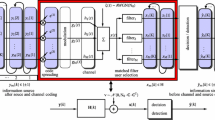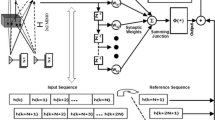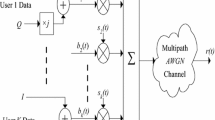Abstract
The Universal Mobile Telecommunications System (UMTS) which is based on Wideband-Code Division Multiple Access (W-CDMA) techniques is one of the most important broadband wireless communication systems. Adaptive Blind Multiuser Detection was widely considered for mobile receivers. The main drawback of this approach is that it achieves the optimum solution after a certain number of bit times. This paper deals with a new neural network approach in order to reduce the convergence time in different application environments. In particular, a modified Kennedy-Chua neural network, based on the Hopfield model is proposed. The neural network stability was investigated by means of a suitable analytical approach, while the performance of the proposed receiver scheme was derived by means of computer simulations. The numerical results shown in this paper highlight a fast convergence behavior of the proposed scheme, in particular under multipath-fading conditions.
Similar content being viewed by others
References
T. Ojanperä and R. Prasad, “An Overview of Air Interface Multiple Access for IMT-2000/UMTS”, IEEE Communications Magazine, Vol. 36, No. 9, pp. 82–95, 1998.
E. Dahlman, B. Gudmundson, M. Nilsson and J. Sköld, “UMTS/IMT-2000 Based on Wideband CDMA”, IEEE Communications Magazine, Vol. 36, No. 9, pp. 70–80, 1998.
M. Honig, U. Madhow and S. Verdù, “Blind Adaptive Multiuser Detection”, IEEE Transactions on Information Theory, Vol. 41, No. 4, pp. 944–960, 1995.
U. Mitra and H.V. Poor, “Adaptive Receiver Algorithms for Near-Far Resistance CDMA”, IEEE Transactions on Communications, Vol. 43, No. 2 – part 3, pp. 1713–1724, 1995.
G.I. Kechriotis and E.S. Manolakos, “Hopfield Neural Network Implementation of the Optimal CDMA Multiuser Detector”, IEEE Transactions on Neural Networks, Vol. 7, No. 1, pp. 131–141, 1996.
K. Das and S.D. Morgera, “Adaptive Interference Cancellation for DS-CDMA Systems Using Neural Network Techniques”, IEEE Journal on Selected Areas in Communications, Vol. 16, No. 9, pp. 1774–1784, 1998.
S.H. Yoon and S.S. Rao, “Annealed Neural Network Based Multiuser Detector in Code Division Multiple Access Communications”, IEE Proceedings – Communications, Vol. 147, No. 1, pp. 57–62, 2000.
A. Hottinen, “Self-Organizing Multiuser Detection”, in Proc. of IEEE ISSTA ‘94, vol. 1, Oulu, Finland, July 1994, pp. 152–156.
J. Joutsensalo and P. Pajunen, “Blind Symbol Learning Algorithms for CDMA Systems”, in Proc. of the 1998 IEEE International Joint Conference on Neural Networks, Vol. 1, Anchorage, AK, U.S.A., May 1998, pp. 152–155.
N. Wang, W.-P. Zhu and B. Zheng, “Blind Multiuser Detection for DS-CDMA Systems: A Neural Network Approach”, in Proc. of ISCAS ‘99, Vol. 5, Orlando, FL, U.S.A., May 1999, pp. 603–606.
J.J. Hopfield, “Neurons with Graded Response Have Collective Computational Properties Like Those of Two-State Neurons”, Proceedings of the National Academy of Sciences, Vol. 81, pp. 3088–3092, 1984.
G. Jeney, J. Levendovszky and L. Kovacs, “Blind Adaptive Stochastic Neural Network for Multiuser Detection”, in Proc. of VTC 2001 Spring, Vol. 2, Rhodes, Greece, May 2001, pp. 1868–1872.
M.P. Kennedy and L.O. Chua, “Neural Networks for Nonlinear Programming”, IEEE Transactions on Circuits and Systems, Vol. 35, No. 5, pp. 554–562, 1988.
R. Fantacci, F. Guidi, F. Rastelli, D. Tarchi and P. Tortoli, “Dsp Implementation of a Neural Network Based Blind Multiuser Receiver for DS-CDMA Communication Systems”, in Proc. of DSP2002, Vol. 2, Santorini, Greece, July 2002, pp. 823–826.
J.G. Proakis, Digital Communications, 3rd edn, McGraw Hill: Singapore, 1995.
S. Verdù, Multiuser Detection, Cambridge University Press: New York, U.S.A, 1998.
S. Verdù, “Minimum Probability of Error for Asynchronous Gaussian Multiple-Access Channels”, IEEE Transactions on Information Theory, Vol. 32, No. 1, pp. 85–96, 1986.
U. Madhow and M.L. Honig, “MMSE Interference Suppression for Direct-Sequence Spread-Spectrum CDMA”, IEEE Transactions on Communications, Vol. 42, No. 12, pp. 3178–3188, 1994.
L. Györfi, “Adaptive Linear Procedures under General Conditions”, IEEE Transactions on Information Theory, Vol. 30, No. 2, pp. 262–267, 1984.
J.M. Zurada, Introduction to Artificial Neural Systems, PWS Publishing Company: Boston, U.S.A., 1995.
D.W. Tank and J.J. Hopfield, “Simple ‘Neural’ Optimization Networks: An A/D Converter, Signal Decision Circuit, and a Linear Programming Circuit”, IEEE Transactions on Circuits and Systems, Vol. 33, No. 7, pp. 533–541, 1986.
L.O. Chua and G.-N. Lin, “Nonlinear Programming without Computation”, IEEE Transactions on Circuits and Systems, Vol. 31, No. 2, pp. 182–188, 1984.
M. Forti and A. Tesi, “New Conditions for Global Stability of Neural Networks with Application to Linear and Quadratic Programming Problems”, IEEE Transactions on Circuits and Systems – Part I: Fundamental Theory and Applications, Vol. 42, No. 7, pp. 354–366, 1995.
R. Fantacci, M. Forti, M. Marini, D. Tarchi and G. Vannuccini, “A Neural Network Based Blind Multiuser Receiver for DS-CDMA Communication Systems”, Dipartimento di Elettronica e Telecomunicazioni, Università di Firenze, Firenze, Italy, Internal Report DET-07-01, 2001.
”Radio Transmission and Reception”, GSM, 07 2002, 3GPP Technical Specification, ver. 8.13.0. [Online]. Available: http://www.3gpp.org
M.W. Hirsch, “Convergent Activation Dynamics in Continuous Time Networks”, Neural Networks, Vol. 2, No. 5, pp. 331–349, 1989.
Author information
Authors and Affiliations
Rights and permissions
About this article
Cite this article
Fantacci, R., Mancini, L., Marini, M. et al. A Neural Network-Based Blind Multiuser Receiver for DS-CDMA Communication Systems. Wireless Personal Communications 27, 195–213 (2003). https://doi.org/10.1023/B:WIRE.0000010149.52740.87
Issue Date:
DOI: https://doi.org/10.1023/B:WIRE.0000010149.52740.87




